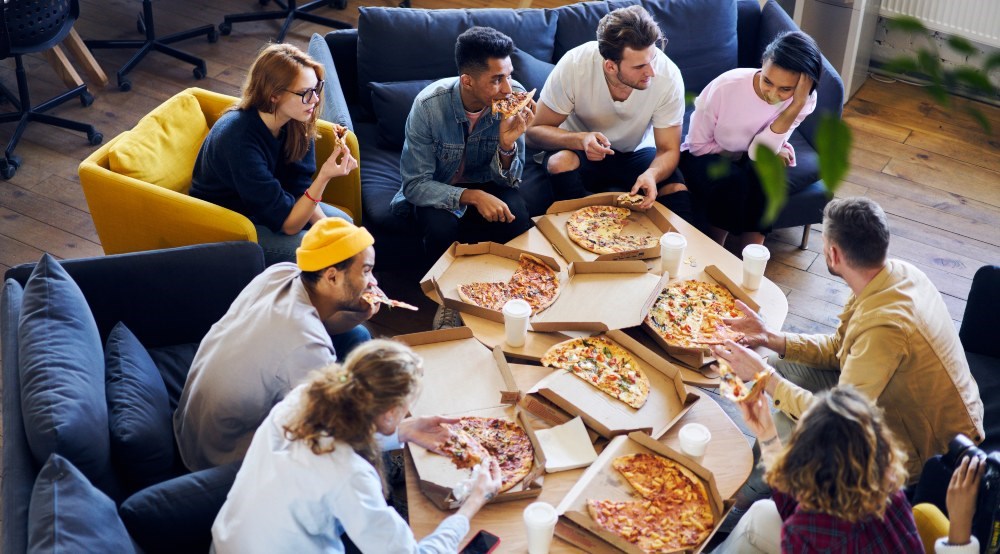
Let us help you with finding an office space
Our experts are here to help take the hard work out of finding your next office space.

For years, businesses have tried to instil more collaborative cultures – methods to do so are wide and varied. Encouraging chance encounters and focusing on listening might be the most successful routes.
In July 2021, Jeff Bezos, the founder of Amazon, stepped down from his role. During his leadership, he developed a series of principles that many loved and many criticised.
One of those included the ‘two pizza rule’. Put simply, “meetings should be small enough that everyone in attendance can be fed with two pizzas.”
It’s thought to help keep meetings more intentional, prevent having too many cooks in the kitchen, and avoid wasting time.
The two pizza rule is one of the many ‘collaboration hacks’ businesses have tried to implement over the years to get their teams working together effectively. Other hacks include standing meetings, so people don’t get comfortable enough to waste time, and prohibiting ‘agenda-less’ meetings. But these tactics don’t always work.
 As the office evolves to host more collaborative (and even social) interactions, these hacks are becoming increasingly topical.
As the office evolves to host more collaborative (and even social) interactions, these hacks are becoming increasingly topical.
Pretty much every leader asked would say they value collaboration. And it’s no surprise as to why – problem solving, productivity and innovation are all by-products of a highly collaborative workforce.
As the office evolves to host more collaborative (and even social) interactions, these hacks are becoming increasingly topical.
But does the two pizza rule oversimplify things? In its purest form, collaboration is working with people effectively, so focusing exclusively on meeting etiquette might be too narrow-minded.
 At Pixar, those becoming managers are required to attend a “90-minute lunchtime class on the art of listening”.
At Pixar, those becoming managers are required to attend a “90-minute lunchtime class on the art of listening”.
Throughout recent history, collaboration hacks have been wide and varied – with office design playing a key role. Though many of us think open plan offices set the foundation for collaboration, the opposite is true.
When they were first introduced, open plan offices resembled factory-like grids, and they encouraged workers to perform repetitive tasks in siloes whilst managers watched from the sidelines.
It was only later, when office design started celebrating the human side of business, that open plan meant collaborative.
And as Nasim Köerting, TOG’s Head of Design, rightly points out: “Collaboration is as much the chance encounter at the coffee machine as it is a formal ideation session in a dedicated breakout space. Being together in one space that encourages social interaction is key.”
The act of moving between spaces is key to that too. Bloomberg’s HQ in Hong Kong, SAR, for example, features a staircase with large landings and seating areas which encourages spontaneous conversations.
 Collaboration is as much the chance encounter at the coffee machine as it is a formal ideation session in a dedicated breakout space.
Collaboration is as much the chance encounter at the coffee machine as it is a formal ideation session in a dedicated breakout space.
Francesca Gino, an author and behavioural scientist, says we’re trying to collaborate in the wrong way. Writing in The Harvard Business Review, she believes that rather than focusing on external factors, we need to encourage a shift in mindset: “Leaders think about collaboration too narrowly: as a value to cultivate but not a skill to teach.”
After studying businesses that displayed ‘sustained collaboration’, Gino noticed a handful of shared mental attitudes: “widespread respect for colleagues’ contributions, openness to experimenting with others’ ideas, and sensitivity to how one’s actions may affect both colleagues’ work and the mission’s outcome.”
And luckily enough, Gino says these traits are teachable. An important first step is encouraging people to listen to one another. So often, we’re nervous about our performance, and we feel the need to fill the silence and make sure our opinions are heard loud and clear. But this can stunt the conversation, lead to conflict, and limit authentic teamwork.
 “Leaders think about collaboration too narrowly: as a value to cultivate but not a skill to teach.” - Francesca Gino, The Harvard Business Review
“Leaders think about collaboration too narrowly: as a value to cultivate but not a skill to teach.” - Francesca Gino, The Harvard Business Review
The brilliant animation company, Pixar, prides itself on a culture of creative collaboration, and learning to listen is fundamental to this. In fact, those becoming managers are required to attend a “90-minute lunchtime class on the art of listening”.
In addition to this, employees are encouraged to build on one another’s ideas by adding a “plus” during brainstorms – just like actors are encouraged to say “yes, and” to any given idea during improvisation.
Back at Amazon, the meeting etiquette is slightly more polarised. One of the tech giant’s 14 leadership principles is “having the backbone to disagree.” Though having said that, Bezos often went round the room to ask what everyone thought of a specific idea so that big personalities weren’t dominating the discussion, proving the value of listening too.
While the two pizza rule might go some way in managing meetings effectively, there’s much more to effective collaboration than meets the eye.

Our experts are here to help take the hard work out of finding your next office space.